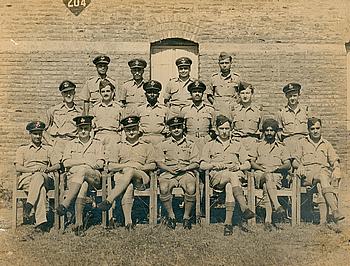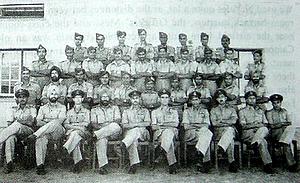VSC Bonarjee was born in Calcutta on the 27th January 1917. He was the third child and only son in a Bengali Christian family. After graduation, He was commissioned in the Indian Air Force in 1940 in the 4th Course as an Observer (IND/1623) and saw action in Burma. He obtained his release as a Wing Commander to join the Indian Administrative Service in 1948. He retired from the I.A.S in 1975, worked for two international organizations till 1989 and lived with his family at Kalyani near Calcutta. In 1997, his friends convinced him to write down his memoirs which were published in the form of a book by Dr Arabinda Dey. He passed away in 2001. The Account on this page is derived from that book – with the kind permission of Dr. Vernon Bonarjee, his son.
VSC Bonarjee was born in Calcutta on the 27th January 1917. He was the third child and only son in a Bengali Christian family. After graduation, He was commissioned in the Indian Air Force in 1940 in the 4th Course as an Observer (IND/1623) and saw action in Burma. He obtained his release as a Wing Commander to join the Indian Administrative Service in 1948. He retired from the I.A.S in 1975, worked for two international organizations till 1989 and lived with his family at Kalyani near Calcutta.
In 1997, his friends convinced him to write down his memoirs which were published in the form of a book by Dr Arabinda Dey. He passed away in 2001. The Account on this page is derived from that book – with the kind permission of Dr. Vernon Bonarjee, his son.
I was born in Ray Street south Calcutta on the 27th January 1917. I was the third child and only son in a Bengali Christian family. I spent my boyhood in east Bengal now Bangladesh. From 1930 to 1932 I accompanied my parents from Calcutta to Rio de Janeiro; Brazil via France stayed there for nearly a year and returned via the U.S.A and Japan. After graduation in science and arts from Calcutta. I was commissioned in the Indian Air Force in 1940. I obtained my release there form as a wing commander to join the Indian administrative service in 1948. My wife is Norwegian by birth. We married in 1953 and have a son our only child, a doctor M.D… PhD (Oslo/Tromso) in Stavanger Norway and three grandchildren (a girl and two boys). I retired from the I.A.S (Indian Administrative Service) in 1975, worked for two international organizations till 1989 and have since lived with my family a retired life in Kalyani near Calcutta in our humble home.
I graduated in science in 1938 from the Scottish church college, Calcutta, got my arts degree thereafter and started my M.A classes in English at the Calcutta University while attending the early morning law classes at the University Law College. I sat for an all India service examination and was praying hard for a job. When WW2 broke out I got my commission as a pilot in the Indian Air Force.
I wore spectacles at the time, but appeared at the medical tests without wearing them and passed. On 1.8.1940 about forty of us joined the Initial Training School for the 4th course of Air Force aircrew training at Walton near Lahore. The pay was quite handsome, but the expenses especially messing charges were also pretty high even without indulging in alcohol or smoke. Munnu Sircar, Hiren Chatterjee, Ronni Sen, Kali Chowdhury,Pasha, Pinto etc are some of the faces which flash across my mind now. After morning P.T (physical training) we had flying lessons and ground subjects in the afternoon, with games in the evenings. I was elected Officer-in-Charge of Mess Property with the responsibility of raising funds to acquire silver for the mess.
In the air I could take over from the pilot and fly quite well; but a safe landing was beyond my skill. This was one of the jobs in the general duties (flying) branch, which meant we had to do various kinds of administrative duties when not flying.
I enjoyed the life and the training and the food. Being a Christian I enjoyed the bacon and eggs, cold chicken and ham rolls, sausages, beef steak etc. which to many of my brother officer-trainees was taboo! The supper nights were informal; but one had to wear the dress as laid down. The dinner nights were ‘parades’ but I got permission to drink the King’s health with Adam’s wine on conscientious grounds (as far as I recollect the late Air Chief Marshal P.C. Lal, then flying officer and one course senior to us had a similar exemption. Like me he neither smoked nor touched alcohol). The guest nights with dancing were also pleasant, but not my specialty! I found no church near Walton so I missed my Sunday morning services especially the monthly Holy Communion. By December 1940 the initial training was over. We went home for a while, before the next session started.
| VSC Bonarjee seen here soon after his commissioning, wearing his Observer Half-Wing. |  |
We joined the No.1 Flying Training School at the R.A.F. station, Ambala in the Punjab in cold December 1940. We spent more time in flying then on the ground. We flew in Wapitis, Harts, Audaxes, and sometimes in Valencias etc. These were mainly old rickety two-cockpit biplanes with fixed undercarriages and an air speed of about a hundred miles per hour. Our colleagues, the trainee pilots flew them while we the observers sat in the rear cockpit and did our Navigation, Signals W/T ( or wireless telegraphy by Morse), air gunnery, bombing, air photography etc., exercises.
COASTAL PATROLS OFF KARACHI
Our coastal defense patrols started at about 06.30 hrs in the morning in biplanes like Wapitis, Harts, and Audaxes etc. We patrolled to find out if any Japanese or German etc submarines (U-boats) were operating under our waters off the coast of Karachi. The pilot sat in the front cockpit and the observer at the back from where he could pass slips to the pilot giving directions on navigation.
Though we carried Verey pistols with the coloured cartridge for the day which colour was secret and also an Aldis lamp. We did not have the occasion to use them during operation to identify ourselves; as our comparatively slow-motion-biplanes needed no identification!
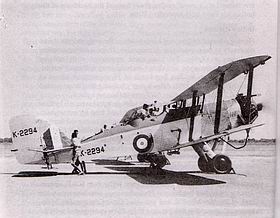 |
Wapiti K2294 of 6CDF undergoes testing of its engine. Note the groundcrew hanging on to the tail to keep the aircraft from nosing over at full power. . |
I was also the R.A.F station photo-officer, as well as the officer-in-charge Intelligence and Security (including secret documents) of our flight unit. We also carried out some night flying exercise. On one such exercise, I think, C.L. Mehta as pilot and Lodhi as observer, crashed on a hill, when I took a team to find them and the crashed Wapiti (or W(h)a(ta)pity!). I also remember that once when practicing air to ground firing from my Lewis gun over sea, suddenly the round flat cartridge-case got a terrific lift from under it and flew away; for which I had to face a court of enquiry. I also remember that once a slip of paper was picked up in the wireless cabin with something like a coded message which could not be decoded. Ultimately it was discovered to be a knitting or sowing pattern jotted out by one of the lady operators and hence beyond the decoding skills of others!
Apart from our flight unit, there were other flying units in the station with aircraft having retractable undercarriages, which had accidents when the pilots forgot to let down the undercarriage and ‘belly’ landed injuring themselves. I remember one F/Lt. Dicky Bird of an R.A.F unit having such an accident which took his leg and foot a good deal of time to recover and be flying fit. Sometimes we spend the day on the naval craft which did the cooperation with us in our “swept channel” work. One of them was commanded by our friend Lt. K.K Mukherjee R.N. who had joined the Royal Navy from the U.K. and was then serving with the Indian Navy (incidentally, as a coincidence he decided to settle in Kalyani like myself after retirement and so we had a good time here with our families till he passed away some years ago).
Our Flight Commander Flt Lt Eric Sprawson, English, was sprightly and jovial and thorough gentleman. It was indeed a pleasure to work under him. We aircrew officers in our flight were all Indians (from different parts of India), except or C.O. But the ground staff and Airmen who maintained the aircraft, guns etc. included many Britishers including our Warrant Officer (the senior most N.C.O. or Non Commissioned Officer) who hailed from Wales).
By the end of 1941 we heard that the Prince of Wales and Repulse, Battle Ships of the British Navy were sunk by the Japanese off Singapore. The British air power viz. the R.A.F. did not seem to have much of a presence there. So, perhaps to counter these losses we took our W(h)a(ta)pitis and audacious Audaxes to Moulmein in south-eastern Burma near the Thailand (Siam in those days) border.
From Calcutta (Dum Dum) we flew over the Bay of Bengal to Akyab where we had a short sojourn for refueling etc. From there we proceeded to a small air strip at Ziatkwin, which was not marked on the map but ‘located’ to me as the navigator by its position in latitude and longitude. We found the place, landed and halted for sometime; tough the place was rather primitive, miles out from town or big village.
Some weeks after this when our aircraft were fortunately on the ground the Japs swooped down from the east i.e. Thailand (then Siam) and strafed our aircraft for twenty minutes or so. This was at about 9 a.m. we had no ack-ack, the trenches were full of red ants, but preferable to the strafing! So we watched our poor aircraft get the bashing, while the red ants got the better of us! We informed Rangoon and almost immediately some American Tomahawk fighters came and the poor Japs had a bad time. Having spent the ire on our rickety, uncamoflouged silver-shining Wapitis, Audaxes etc. they were caught defenseless and made easy meat!
We did not stay long at Bassein. At 8 a.m. Burma time on a day in February, 1942 Fg Offr Munshie and myself as navigator, and another aircraft perhaps with Fg Offr Choksey as the pilot left Bassein. We refueled at Chittagong and proceeded to Calcutta (Dum Dum) which had black-out, hence it was difficult to locate the aerodrome at night, but the Bally Bridge could be seen. As I knew the direction of the aerodrome from the bridge, we spotted it and the two pilots made wonderful night landings without any landing light on the tarmac. The ground staff at Dum Dum and the folks in the Officer’s mess gave us a pat on the back; but we knew that it was not our skill but only our guardian angels who did the trick! So, that ended our Burma campaign with a safe return in rather unsafe, damaged and patched up aircraft!
After a few day rest in Calcutta we were posted back to Drigh Road, Karachi with the same type of aircraft but renamed as No.6 flight and Flt Lt Sprawson in command. We got a few Lysanders added to our flight and resumed our ‘naval cooperation Swept Channel patrols’ in March, 1942. To our delight we found Lt. K.K. Mukherjee R.N. still commanding the naval craft which cooperated with us before and we, especially Ronni Sen and myself, spent a day in his ship now and then.
DIVE BOMBING TRAINING
The pilots ‘converted’ to Vultee Vengeance aircraft while we observers practiced more navigation etc. and dive bombing occasionally. Photos were taken by switching on the camera on the dive taking a series of pictures on the downward journey of the bombs, and the targets before and after the blast. The dive brakes were switched on just before the dive, which jutted out at right angles from the wings and reduced the speed. We could dive without oxygen from 15,000ft to about 2,000ft before pulling out, at which point the aircraft was almost stationery and very vulnerable to ack-ack fire or enemy fighter aircraft. We did some flying with navigation etc. exercises in Harvard’s and Anson’s also.
DIVE BOMBING OPERATIONS
Sometimes I flew as the observer for the whole squadron of twelve dive bombers in flying formation. To prevent detection by the enemy there was no wireless inter-com between aircraft. My job was not only to take the formation to the target and back after bombing but to increase fire control by the rear gunners when attacked by enemy fighters i.e. to wait till an enemy fighter came within range and then to fire at it all together from all the rear guns. Sometimes we had to use Aldis lamps for inter-com visually.
We had already moved from Peshawar to Maharajpur when Flt Lt Lal and myself ferried part of the squadron to Kumbhirgram near Silchar in Assam via Allahabad and Alipore. From the middle of March, 1944 when the North-western storms, followed by the south west monsoon, were in full fury we did our dive bombing operations stemming the Jap advance from Burma to India. The weather was frequently very dangerous for ordinary flying not to speak of dive bombing with deep sucking downward conventional currents over the fairly high hills between Burma and India. The snow white towering Himalayas to the north were equally menacing vying with the beautifully red Jap flak coming from the target below, in Burma off Mandalay, Kalewa etc.
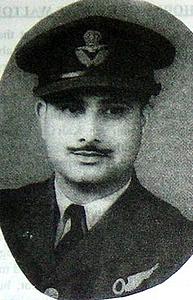 |
Bonarjee seen in later years. |
The takeoff was at about 06.30hrs in a Vultee Vengeance Dive Bomber with 2x500lbs h.e. (high explosive) bombs, ‘delayed action’ upto 72hrs or so, or just ordinary, to explode on hitting the ground. Generally we flew as a box of 6 or 12 aircraft with Flt Lt Lal as the leader and myself in his rear cockpit as the observer/navigator-cum-gunnery leader-cum-photographer for the whole squadron or flight as the case maybe. Flying in close formation we dive bombed over the target in quick succession sometimes from 15, 000ft without oxygen, to about 8,000ft, If there was a flak and down to 2,000ft if there was no flak. It would generally be a Jap ammunition dump or bunker or advancing army columns or Road Bridge or important junction etc. We took auto photos while on the vertical dive, over the target, shaking severely with the dive brakes out!
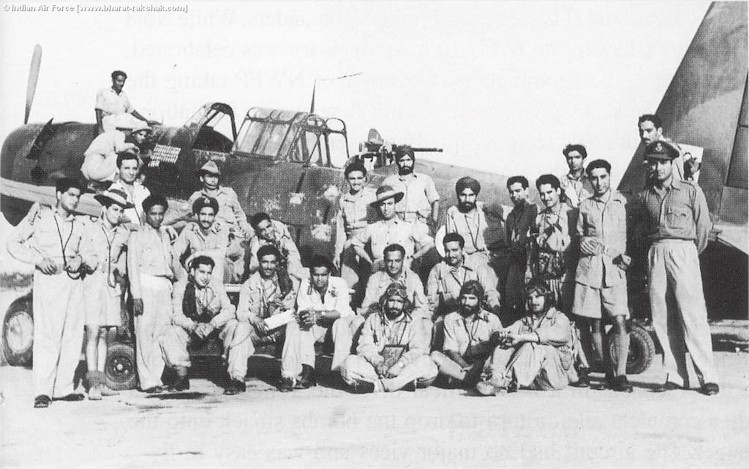 |
| No.7 Squadron’s aircrew posing with one of their Vengeance Aircraft. Seen sitting in the center is the CO Sqn Ldr Hem Chaudhury, with Flt Lt PC Lal standing behind him (in bush hat). Flt Lt Erlic Pinto sitting 3rd from left. Fg Offr KS Bhat standing at the left of the photo. Fg Offr Dolly Engineer, standing 2nd from Right. VSC Bonarjee is sitting right most on the ground. Photo Courtesy: Vayu Aerospace |
My 2nd sortie, if any, would start at about 1600 hrs, similarly in a box or 6 or 12 with Flt Lt Pinto or some other pilot in some other Vultee Vengeance plane, returning by 1800 hrs or so. I did the maximum number of sorties during that ‘ops tour’ and was awarded a ‘Mention in Dispatches’ by the king’s order which was published in the London Gazette on the 1st January, 1945. it was signed by Archibald Sinclair, Secretary of State for Air.
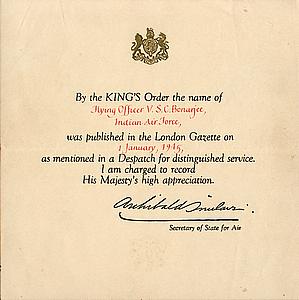 |
VSC Bonarjee’s Mentioned-in-Dispatch certifcate signed by Archibald Sinclair, Secretary of State for Air. The name can be seen in the London Gazette on the 1st January, 1945 |
| Wg Cdr VSC Bonarjee’s Medals from his WW2 Service – L to R : Indian Independence Medal (1947), 1939-45 Star (With Mentioned-in-Despatches Oak Leaf emblem) , Burma Star, The India Defence Medal, the 1939-45 War Medal. View Rear Side of the Medals |
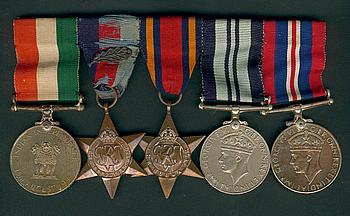 |
In mid June, 1944 I was relieved of operational flying and did such jobs as the Group Navigation Officer in R.A.F. Group Headquarters at Peshawar, the C.O. if the Air Navigation School at Tambaram at Madras, (where a delegation of the Empire Air Navigation School, U.K. visited my school and gave us a good report and a good write-up in the British magazine named Flight), the station administrative officer, R.A.F. station, Ambala and lastly as Wg Cdr, commanding the R.I.A.F. Depot, or airmen’s training center, at Jallahalli near Bangalore.
From the R.I.A.F. depot Jallahalli I got my release from the Indian Air Force in June, 1948 and joined the I.A.S. (Indian Administrative Service), in Calcutta, Government of West Bengal. And thus my days in the I.A.F. – 1940-1948 ended.
I did not marry during my Air Force Days; but as prayed for, god gifted me my Norwegian (Indian since 1962) wife in 1953 when I was the district magistrate and collector of Malda. I retired from the I.A.S. in 1975 and worked thereafter as Deputy Director, Lutheran World Service, India upto, 1984and thence upto 1989 as Director in another international rural development etc. organization. Since then my wife and I live in our home in Kalyani near Calcutta; and our M.D PhD son lives in Norway with his Norwegian wife, daughter (14) and two sons (12 and 9) (in1995) in his own home in Stavanger, Norway. We visit them and they visit us from time to time. We thank HIM!
Acknowledgements :
Dr Vernon Bonarjee for the permission to reproduce this article on this website, as well as re-scans of some of the photographs and documents.
Philbert Periera for transcribing the article
Vayu Aerospace Review for the photograph of No.7 Squadron.
Copyright © DR. VERNON BONARJEE. All rights reserved. Reproduction in whole or in part in any form or medium without express written permission of © DR. VERNON BONARJEE is prohibited.
